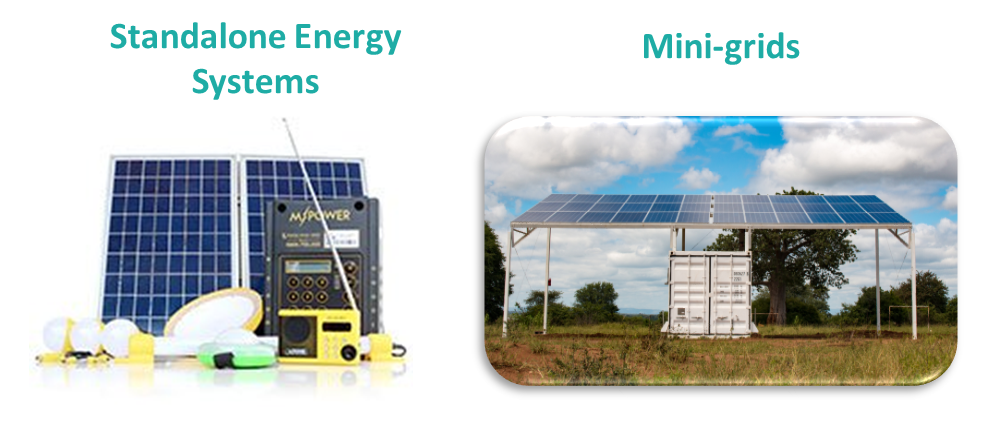
While investors and development agencies have shown a lot of interest in off-grid electrification projects lately, the practical limits of traditional project finance require innovative approaches to support these projects. To date, two popular business models have emerged on the African continent in response to energy needs of off-grid customers, including:
- Standalone Energy Systems: energy solution for individual users/applications typically without utility grid connection (e.g. solar home systems for basic lighting, phone charging, radios, and TV) and often requiring innovative financing for users (e.g. pay-as-you-go with mobile payments, leasing)
- Mini-grids: small grid system electrifying a number of users or a community typically without utility grid connection and requiring some form of battery storage with power supply (e.g. solar PV panels, wind turbine, generator). Metering equipment allows each residence to track and pay for their usage separately.
Both of these approaches have grown considerably in recent years. In 2016 alone, Global Off-Grid Lighting Association (GOGLA) members sold over 4 million portable solar lights and home systems mostly in Africa and Asia. Likewise, the UN estimates that universal access to power in Africa will require as many as 350,000 mini-grids. A recent report from the IFC also estimates that energy storage will grow 40% per year in for the next 10 years in emerging markets, which will further enable off-grid projects as storage technologies become more affordable and wide spread.
Challenges
Off-grid project investment typically involves a large number of projects with small investment levels and higher risk profiles relative to larger utility-scale projects. Financing many investments at a smaller scale, is a common challenge facing both mini-grids and standalone energy systems.
In addition, mini-grids and standalone energy system firms both have to overcome the hurdle of off-taker credibility demonstrating to financiers that their customers will make reliable payments for the service provided to be considered a bankable investment and secure the debt/equity they need to scale. Government guarantees of payment for mini-grids helps to overcome this, along with DFI support which can lower off-taker risk. Private investors prefer a strong relationship with a single developer or company, as it is simpler to offer corporate loans rather than evaluate projects or deployments individually. Corporate loans, however, face a chicken or the egg dilemma, as developers need enough projects on their balance sheet to justify funding. This highlights the important role that DFI funding (e.g. low interest debt) still plays in this high risk market.
Mini-grid projects also have to overcome challenges such as licensing, connection costs, future grid arrival, and the potential tariff differential between the cost of energy from the mini-grid and the utility’s tariff. These challenges are an even greater factor in the emerging market context, as off-grid communities have yet to be connected to the grid, but expect a similar level of service for on-grid customers who often benefit from government subsidies.
Potential Solutions
In order to address mini-grid issues some countries like Senegal, have competitively allocated licenses by region to developers, NGOs, and community groups who intend to deploy mini-grid projects. These awarded concessions last for 25 years and divide the country into ~10 priority regions with future support expected from a levy on electricity tariffs. Another option under consideration will leverage carbon finance to subsidize connections costs or government funding to subsidize the differential between the cost of energy from the mini-grid and the utility’s tariff. Nigeria has reduced planning risk associated with future grid connectivity to off-grid areas by giving mini-grid operators the option to either convert their system to a grid-tied system or accept a once-off payment equal to the depreciated value of the assets plus a year of sales revenue. In parallel, Nigeria is also rolling-out 20,000 standalone energy systems with the help of Azuri.
For standalone systems and sustainable products, it is clear there isn’t a one size fits all solution. Many firms like Azuri offer standalone energy systems with financing to customers in the form of leases or a pay-as-you go model with a mobile payment option. M-Kopa has been very successful with this in East Africa where they connected over 400,000 homes as of mid-2016 with their solar PV systems using a mix of private equity and funding from a local bank to pass on affordable financing for their customers. A results-based finance approach worked in Tanzania where companies received an incentive of up to 50 euros per customer in a priority off-grid area that was sold or leased as a standalone solar energy system.
Since mobile banking solutions and payments are emerging as the preferred method of payment for customers, expansion of telecommunications infrastructure in parallel with electrification efforts enables more of these business solutions to reach remote areas. Off-grid companies know this and are realizing that significant business opportunity exists from building long-term relationships with customers to expand the initial system and offer other services.
From recent experience, it is clear that the off-grid market is a dynamic and high growth industry as technology can be deployed faster and cheaper than utility-scale expansion in many areas. As customer’s energy needs and ability to pay grows, demand will also increase for larger mini-grids and other services for these communities. DFIs will continue to play a key role in the near-term with affordable financing to help crowd-in private sector finance rather than compete with it. Investors and private companies already know there is significant opportunity here, but the most successful ones will continue to find new ways to finance these projects and adapt with the off-grid market.
Note: Photos sourced from Standard Microgrid (StandardMicrogrid.com) project in Zambia & standalone energy system from Offgrid-Electric.com
